This article was medically reviewed by Jody Leng, MD. Dr. Leng is a board certified Anesthesiologist and a Clinical Assistant Professor of Anesthesiology, Perioperative and Pain Medicine at Stanford University. She completed a fellowship in Regional Anesthesiology at the Stanford Medical Center in 2014. She is a member of the California Society of Anesthesiologists and was awarded the Teaching Excellence Award by the Stanford University School of Medicine in 2016.
There are 13 references cited in this article, which can be found at the bottom of the page.
wikiHow marks an article as reader-approved once it receives enough positive feedback. In this case, several readers have written to tell us that this article was helpful to them, earning it our reader-approved status.
This article has been viewed 168,358 times.
When a patient is placed under general anesthesia, that patient is unconscious and unaware of pain. This state is often produced using intravenous drugs and inhaled gasses that cause the patient to “sleep;” however, this state is not like regular sleep. General anesthesia should only be administered by an anesthesiologist or nurse anesthetist. This specially trained medical professional will determine the correct medications, monitor your breathing and bodily functions during surgery and will constantly treat ongoing changing physiologic processes, depending on the state of health of the patient and what is happening during surgery. The medications used to induce general anesthesia are dangerous and require the skills of an expert physician. Never attempt to use these techniques at home.
Steps
Preparing to Administer Anesthesia
-
1Review the patient’s medical record. Before administering anesthesia, the anesthesiologist will review the patient’s medical record. This review process helps to ensure that the medications the patient receives is the safest and most effective for each for. The anesthesiologist will look at a patient’s:[1]
- Age
- Weight
- Medical history
- Current medications including prescriptions, over-the-counter drugs, and herbal supplements
- Prior anesthetic records, if available
- Recent medical studies or specialist visits relevant to the type of anesthetic planned (for example, recent cardiology notes, echo reports)
- Other relevant medical history and details relevant to the type of anesthesia planned
- Allergies to medications and to food products
-
2Ask the patient about medications. Next, the anesthesiologist will speak with the patient. The anesthesiologist will let the patient know what to expect and about the potential side effects of these medications.[2]
- It is important for the anesthesiologist to know about any past reactions to anesthetics. If a patient has had a bad reaction to any anesthetic agents in the past or if the patient has a significant family history of problems with anesthesia, the anesthesiologist may choose to use different medications.
Advertisement -
3Interview the patient about alcohol, cigarette, and recreational drug use. The anesthesiologist will ask the patient about the patient's current use of alcohol, cigarettes, and recreational drugs. All of these substances have the potential to affect the way that a patient responds to anesthesia, so it is crucial for the anesthesiologist to learn this information.[3]
- Cigarettes affect the heart and lungs, which can affect the type of anesthesia chosen and recovery process. Chronic obstructive lung disease can significantly impact a patient’s ability to recover from intubation. It is recommended to quit smoking at least eight weeks prior to any anesthetic to improve outcomes from anesthesia and to decrease the risk of surgical infection.
- Alcohol affects the liver, heart, lungs, and blood, which are important in the administration of anesthesia. Chronic liver disease can significantly impact the choice and outcomes of anesthesia.
- Current or past use of recreational drugs, such as cocaine, marijuana, or amphetamines, is important information for an anesthesiologist to learn. If cocaine or amphetamines are present in the bloodstream, they can lead to dangerous changes in blood pressure and even death under general anesthesia.
- Remember that all conversations between patient and doctor or anesthesiologist are confidential. Not sharing this information it could increase the possibility of negative side effects from the surgery, including death — make sure the patient knows how essential it is that he be honest with you.
-
4Confirm that the patient has abstained from food and fluid as instructed. Doctors instruct patients to abstain from food and fluid for a specific amount of time before surgery. However, the anesthesiologist will often confirm this information.[4]
- Any food in the stomach during surgery increases the risk of aspiration during surgery. This is the medical term for when food and gastric contents rise up into the esophagus and enters the lungs during surgery. Even candy or chewing gum without swallowing can increase a patient’s risk of aspiration
- Because general anesthesia also puts to sleep the musculature in your body you won’t have a gag reflex and will not be able to cough to protect your lungs. Do NOT eat or drink anything during the time period your surgeon gives you prior to surgery. Aspiration can lead to prolonged intubation and ICU stays, and sometimes even death.
Administering General Anesthesia
-
1Place an IV. Prior to being taken to the surgical suite a nurse or anesthesiologist will put an intravenous line (IV) into the patient’s arm. The intravenous (IV) line in the patient’s arm will be used during surgery. In many cases a second IV is inserted in the other arm after the patient is under anesthesia.
- The patient may receive a sedative in the preoperative area before moving to surgery. The sedative will help the patient to relax.[5] An anesthetist may have to use more medication to achieve general anesthesia if a patient is highly anxious.
- Prior to surgery, the patient will go to sleep by receiving general anesthetics through the IV and sometimes through a face mask as well. Delivering the anesthesia through the mask alone is also an option that may be used in some cases. For example, if the patient is a child who is afraid of needles, then a mask may be used to administer medications.[6]
- This option, called “mask induction,” is not often used in adults or larger children, because it can be less effective and risky to induce general anesthesia without first securing an IV.
-
2Intubate the patient. Because many anesthetic medications will prevent patients from breathing adequately on their own, the anesthesiologist will want to secure the patient’s airway, usually with either a laryngeal mask airway or an endotracheal tube. Placement of an endotracheal tube is called intubation. In this procedure, the anesthesiologist will place a tube into the patient’s trachea in order to protect the lungs and help the patient breathe during surgery. This tube will be hooked up to a machine that will help the patient breathe during the procedure.[7]
- The endotracheal tube used in intubation is a flexible plastic tube that goes through the patient’s mouth with the help of an instrument called a laryngoscope. This instrument helps the anesthesiologist lift up the tongue and pharynx, or tissues of the mouth, in order to see well enough to pass the tube into the patient’s lungs.
- Because intubation usually happens when the patient is asleep, patients may occasionally have a cut lip or chipped tooth if placement of the endotracheal tube was difficult. It is important for patients to notify their anesthesiologist if they have loose teeth, which can increase this risk.
- After surgery, some patients will have a sore throat from the endotracheal tube. This can last one to two days and is a normal side effect of intubation
-
3Be aware of the potential complications from intubation. Complications from placing the tube down the esophagus toward the stomach instead of the lungs will result in inadequate oxygenation, brain damage and possibly death. For this reason a qualified and experienced physician places the endotracheal tube and checks placement before the start of surgery. Other complications from endotracheal intubation include:[8]
- Knocking out a tooth during insertion of the tube, or intubation
- Damage to the lips, teeth or tongue
- Low blood pressure from the anesthetic medications
- Lung infection, such as pneumonia, more so with prolonged intubation
-
4Take extra precautions if the patient is at risk for complications from intubation. Some patients are at a higher risk of complications from intubation, which is why it is so important to review the patient’s medical history and perform a physical exam. Patients that are at high risk for a difficult intubation may require an awake intubation, which can be performed with numbing medicine and sedation. This is done to ensure the patient’s safety, and after the endotracheal tube is in place, the anesthesiologist will then provide anesthesia medications.Factors that increase the risk of difficult intubation include:
- Neck or cervical spine injury that limits flexion or extension of the neck
- Thick neck circumference
- Small mouth opening
- Small chin or inability to move the jaw forward
- Previous head or neck radiation or surgery
- Recent meal
-
5Monitor the patient’s vitals. Once the patient is under anesthesia from IV or inhaled induction, with a secure airway and appropriate ventilation, the anesthesiologist will monitor the patient’s vital signs and treat the patient with a variety of medications and fluids to keep her stable throughout surgery. The anesthesiologist will communicate with the surgeon throughout the procedure to ensure the patient’s safety. The vital signs that the anesthesiologist will monitor include:[9]
- Oxygen saturation levels
- Heart rate and rhythm
- Blood pressure
- Respiratory rate
- Body temperature
- Blood loss
- Urine output, depending on the type of surgery
- Central venous pressure, depending on the type of surgery
- Cardiac output and other invasive cardiac monitoring, depending on the patient or type of surgery
Waking Up After General Anesthesia
-
1Keep the patient under anesthesia until the procedure is over. The patient will continue to receive medication to stay sedated until the surgeon has completed his or her procedure. After the procedure is complete, the anesthesiologist will reduce the use of the medication. Before removing the endotracheal tube the anesthesiologist will ensure that the patient:
- Is breathing adequately without assistance
- Has stable vital signs
- Has had appropriate medications and reversal agents, if necessary
- Can follow basic commands and demonstrate good muscle strength, usually by lifting his or her head or squeezing somebody’s hands
-
2Take the patient to the recovery room. After the endotracheal tube has been removed and the patient has been woken up completely, the patient will be taken to the recovery room. In the recovery room, expert nurses will monitor the patient’s vital signs (oxygen saturation, heart rate and rhythm, blood pressure, and temperature) to ensure that everything is normal. The nurse will also monitor for and treat common side effects of anesthesia and surgery, including pain and nausea.[10]
-
3Watch for common side effects. Like any other medical procedure, there can be side effects from general anesthesia. Most of these side effects will go away soon after surgery, but if any of these side effects are severe or persistent, seek medical attention right away. Common side effects of general anesthesia include:[11]
- Nausea
- Vomiting
- Sore throat
- Confusion
- Muscle aches
- Chills/shivering
- Itching
-
4Seek immediate medical treatment for more serious side effects. Some patients may also experience more serious side effects from general anesthesia that require medical care from a doctor. Serious side effects that require medical attention include:
- Difficulty breathing
- Signs of infection, such as fever or chills
- Chest pain or pressure
- Heart palpitations
- New weakness
- Arm or leg swelling and/or fatigue, which can be signs of heart failure
-
5Be aware of the potential for serious complications. After surgery, you may be at higher risk for developing other more serious complications. Notify a doctor right away if the patient suffers from any complications. Some complications to watch out for include:[12]
- Postoperative delirium. This complication causes confusion and memory loss which can last longer than a few hours. Some patients are at a higher risk, such as people who are transferred to intensive care after surgery, as well as those with heart disease, lung disease, Alzheimer’s disease, Parkinson’s disease, or who have had a stroke.
Understanding Other Types of Anesthesia
-
1Learn about local anesthesia. Unlike general anesthesia, local anesthesia will only numb a small part of the body. This type of anesthesia is used only for minor procedures. The patient may be awake during the procedure.[13]
-
2Find out about regional anesthesia. Regional anesthesia will block the perception of pain from a larger portion of the patient's body. In this case the patient may also receive a sedative. Regional anesthesia can be provided as an alternative to general anesthesia, or sometimes in combination with general anesthesia. There are two types of regional anesthesia.
- Peripheral nerve block. In this procedure, anesthetic is injected adjacent to a specific group of nerves.
- Epidural or spinal anesthesia. In this procedure, local anesthesia is injected near the spinal cord, which blocks pain from the nerves in the spine. This will block pain in a region of the body such as the chest wall, hips, legs or belly.[14]
-
3Ask about conscious sedation. Conscious sedation is a type of anesthesia involving sedation without being entirely "asleep" or unconscious. This option allows a patient to be somewhat sedated and comfortable while undergoing surgery.[15]
- Most of the time a nurse, doctor or dentist will administer the sedation using a medication that wears off quickly.
- The medication is given through an IV and requires monitoring every three to five minutes.
- The patient will likely get oxygen through a mask during the procedure.
- Patients often fall asleep but will wake easily and respond to people in the room upon waking.
- Some medications used also induce amnesia so the patient may not remember much about the procedure.
- The patient may hear voices and drift in and out of sleep, all of which would be normal for conscious sedation. Awareness during conscious sedation does not mean the patient “woke up” during surgery and it is an expected part of this mild type of sedation.
Warnings
- Only licensed doctors or certified registered nurse anesthetists should ever administer anesthesia. Small errors can result in the death of a patient.⧼thumbs_response⧽
References
- ↑ http://www.pamf.org/anesthesiology/procedures/general.html
- ↑ http://www.hopkinsmedicine.org/healthlibrary/conditions/surgical_care/types_of_anesthesia_and_your_anesthesiologist_85,P01391/
- ↑ http://www.hopkinsmedicine.org/healthlibrary/conditions/surgical_care/types_of_anesthesia_and_your_anesthesiologist_85,P01391/
- ↑ https://my.clevelandclinic.org/health/treatments/15286-anesthesia/
- ↑ http://journals.lww.com/anesthesia-analgesia/Abstract/1999/12000/Preoperative_Anxiety_and_Intraoperative_Anesthetic.3.aspx
- ↑ https://kidshealth.org/en/teens/anesthesia-types.html
- ↑ https://aam.ucsf.edu/endotracheal-tubes
- ↑ https://www.uptodate.com/contents/complications-of-the-endotracheal-tube-following-initial-placement-prevention-and-management-in-adult-intensive-care-unit-patients
- ↑ https://www.asahq.org/madeforthismoment/anesthesia-101/role-of-physician-anesthesiologist/
- ↑ https://kidshealth.org/en/teens/anesthesia-types.html
- ↑ https://my.clevelandclinic.org/health/treatments/15286-anesthesia
- ↑ https://www.asahq.org/madeforthismoment/anesthesia-101/effects-of-anesthesia/
- ↑ https://www.nigms.nih.gov/education/fact-sheets/Pages/anesthesia.aspx
- ↑ https://www.ncbi.nlm.nih.gov/books/NBK542219/
- ↑ https://medlineplus.gov/ency/article/007409.htm
About This Article
To administer general anesthesia, first confirm with the patient that they have abstained from food and fluid as instructed, since any food can increase the chance of aspiration during surgery. Then, insert an IV line into the patient’s arm, through which the anesthetic will be delivered. Depending on the patient and the surgery, you may also administer gas through a face mask. Once the patient is under anesthetic, you should also insert an endotracheal tube or apply a laryngeal mask to secure the patient’s airway. Additionally, you should monitor the patient’s vitals, including heart rate and rhythm, blood pressure, and oxygen saturation levels. For more tips from our Medical co-author, including how to support a patient once the anesthetic wears off, read on!




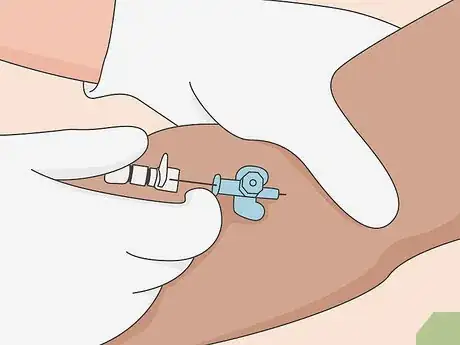
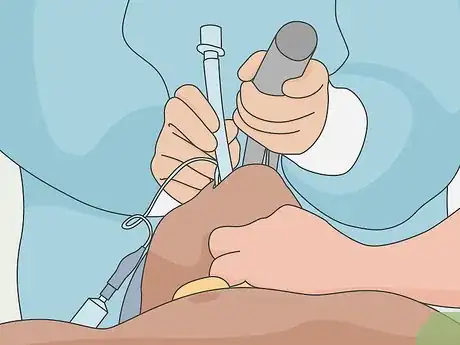


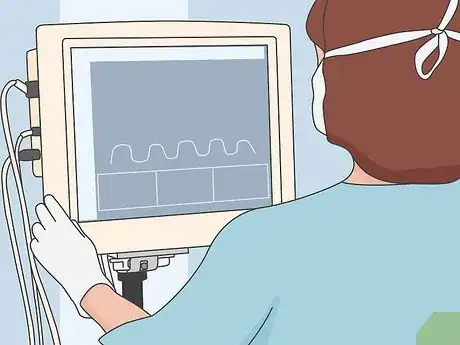
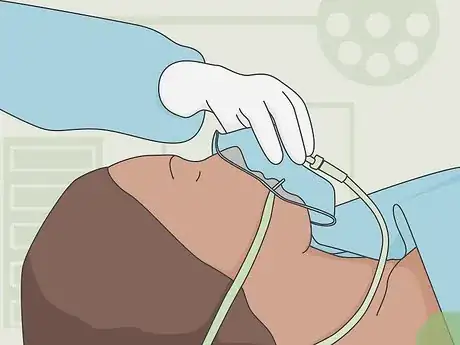




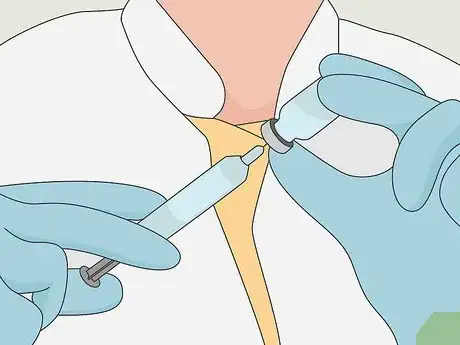




























































Medical Disclaimer
The content of this article is not intended to be a substitute for professional medical advice, examination, diagnosis, or treatment. You should always contact your doctor or other qualified healthcare professional before starting, changing, or stopping any kind of health treatment.
Read More...